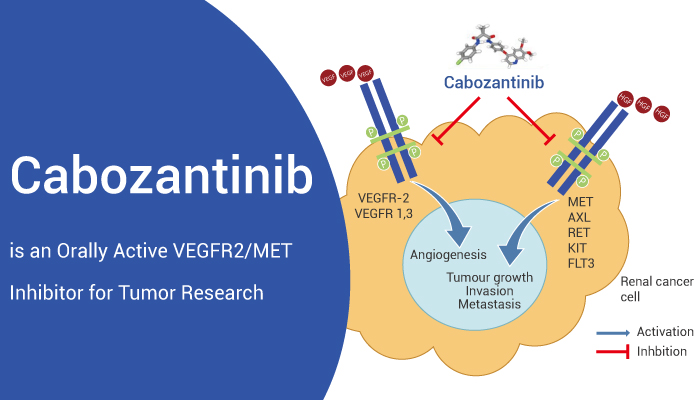An angiogenesis inhibitor is a substance that inhibits the growth of new blood vessels (angiogenesis). Some angiogenesis inhibitors are endogenous and a normal part of the body’s control and others are obtained exogenously through pharmaceutical drugs or diet.
While angiogenesis is a critical part of wound healing and other favorable processes, certain types of angiogenesis are associated with the growth of malignant tumors. Thus angiogenesis inhibitors have been closely studied for possible cancer treatment. Angiogenesis inhibitors have potential treatment applicable to many types of cancer. But the limitations of anti-angiogenic therapy have been shown in practice. Currently, angiogenesis inhibitors are recognized for their improvement of cancer immunotherapy by overcoming endothelial cell anergy.

Cabozantinib is a VEGFR2/MET Inhibitor for Tumor Research
Cabozantinib (XL184; BMS-907351) is a potent and orally active inhibitor of VEGFR2 and MET, with IC50 values of 0.035, and 1.3 nM, respectively. Besides, Cabozantinib also displays strong inhibition of KIT, RET, AXL, TIE2, and FLT3 (IC50=4.6, 5.2, 7, 14.3, and 11.3 nM, respectively). Furthermore, it shows antiangiogenic activity and disrupts tumor vasculature and promotes tumor and endothelial cell apoptosis.
In vitro, Cabozantinib inhibits phosphorylation of MET and VEGFR2, as well as KIT, FLT3, and AXL with IC50 values of 7.8, 1.9, 5.0, 7.5, and 42 μM, respectively. Cabozantinib (0-370 nM, 24 h) inhibits cellular migration and invasion. Cabozantinib (48 h) inhibits tumor cell proliferation in a variety of tumor types. In vivo, Cabozantinib (100 mg/kg, Oral, once) inhibits MET and VEGFR2 phosphorylation in mice. Also it significantly increases tumor hypoxia and apoptosis. Cabozantinib (0-60 mg/kg, Oral, once daily for 14 days) inhibits tumor growth in a dose-dependent manner.
In conclusion, Cabozantinib is a VEGFR2/MET inhibitor and shows antiangiogenic activity for tumor research.
Reference:
[1] Mol Cancer Ther, 2011, 10(12), 2298-2308.
[2] Cancer Res, 2011, 71(14), 4758-4768.